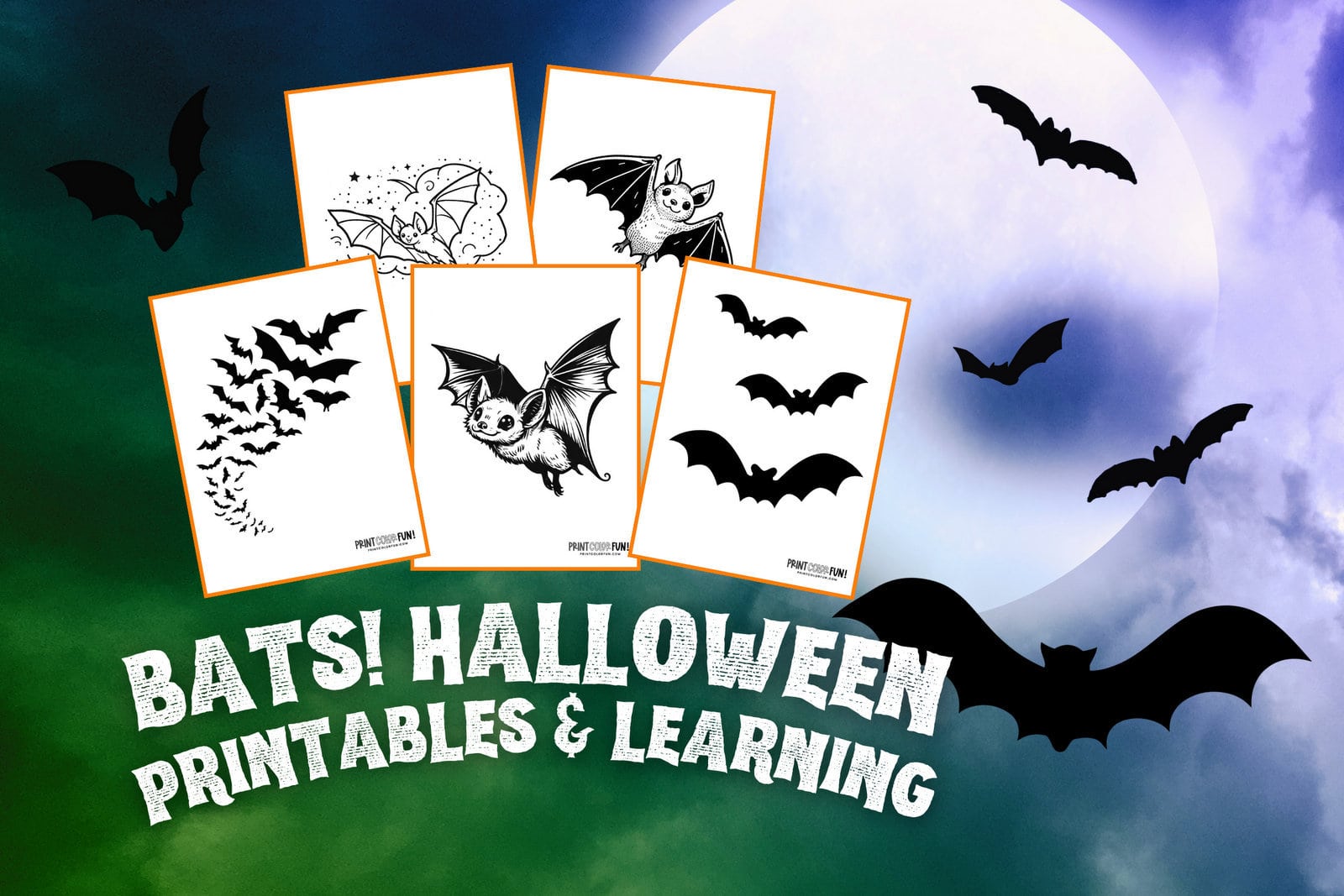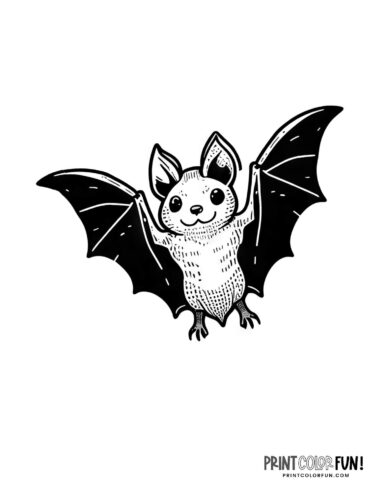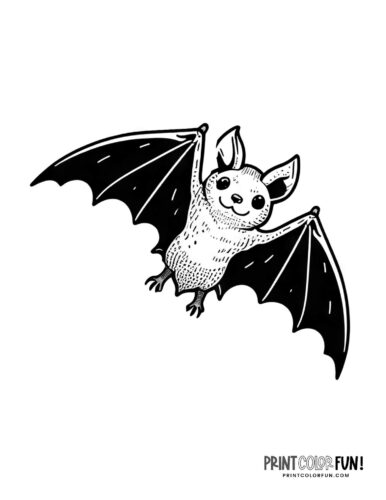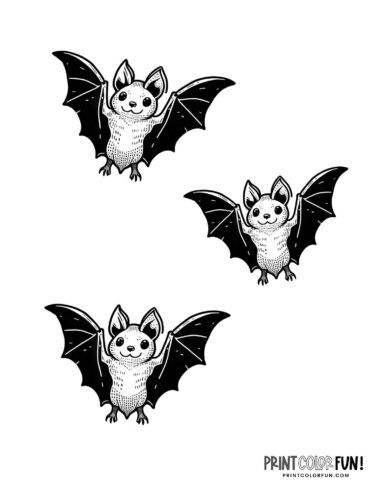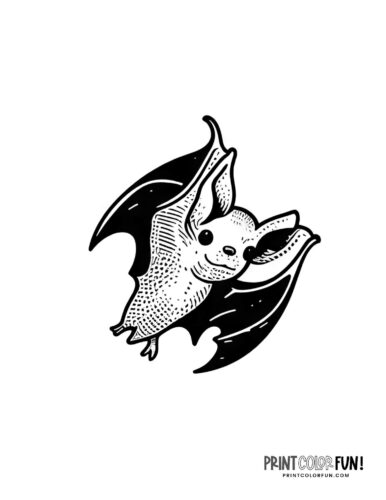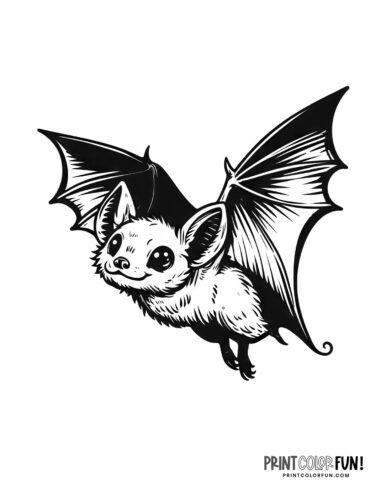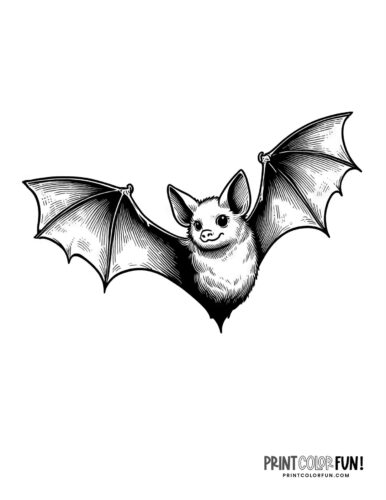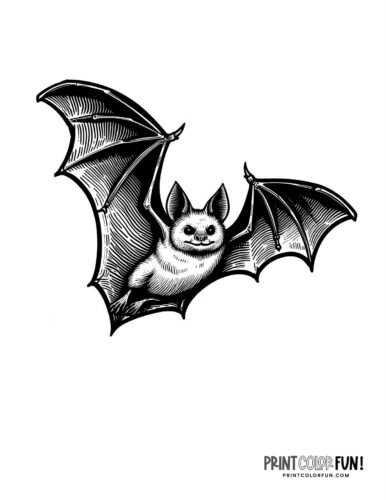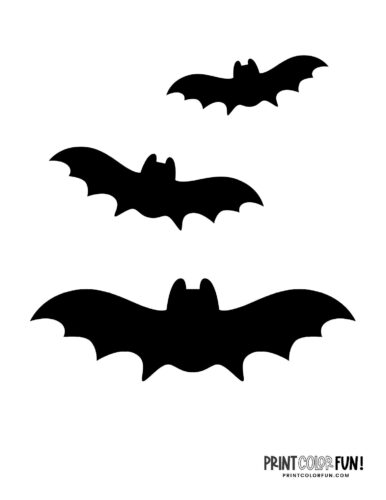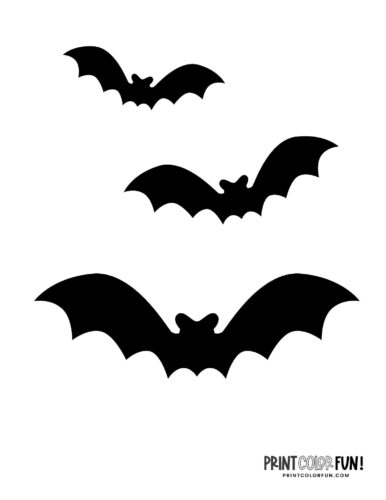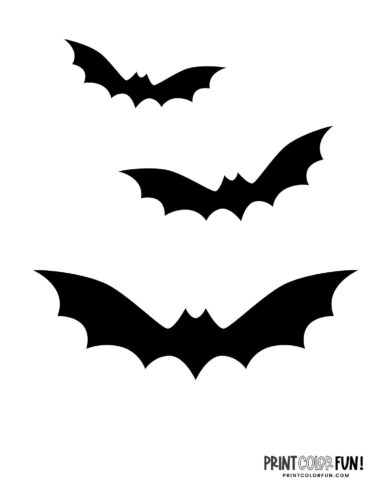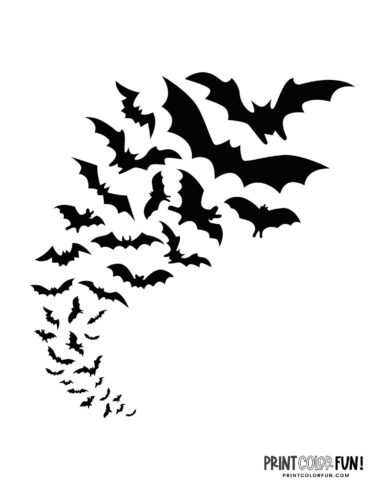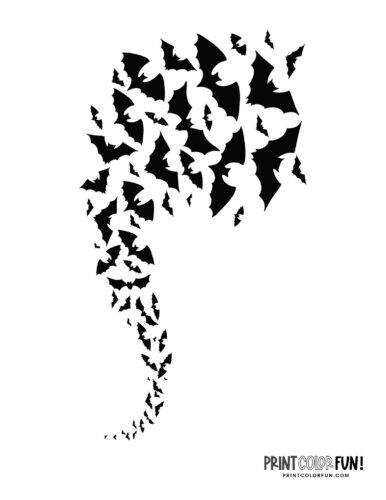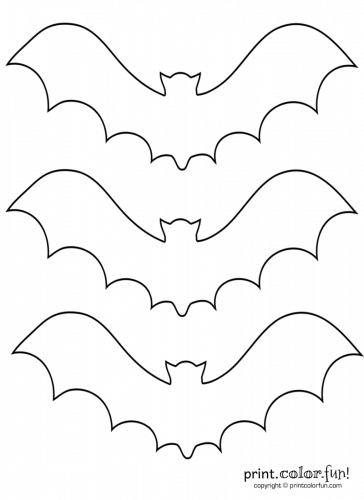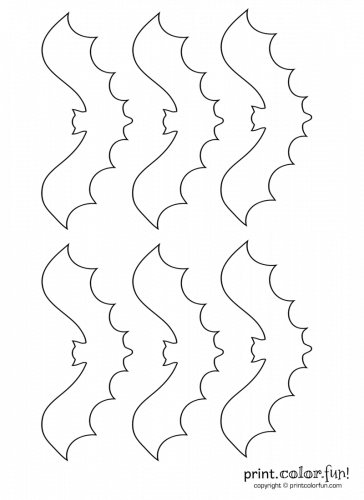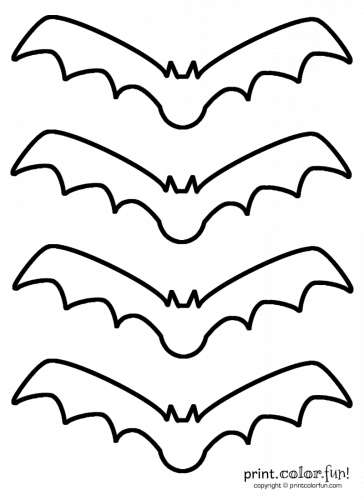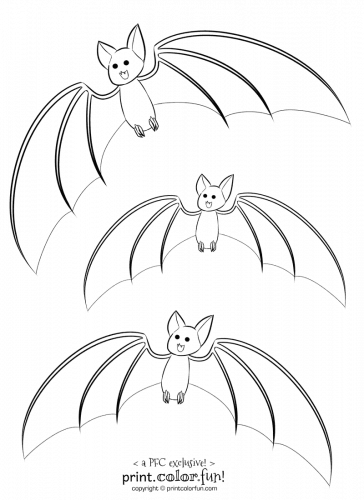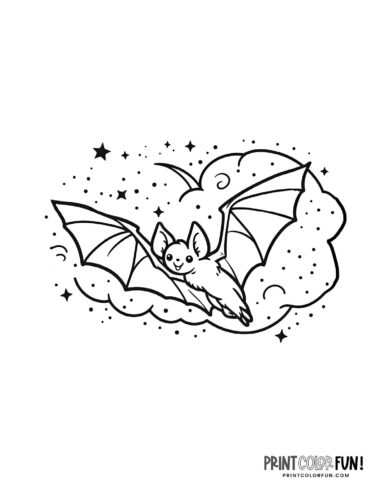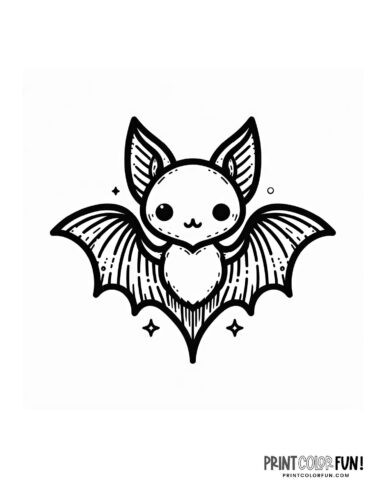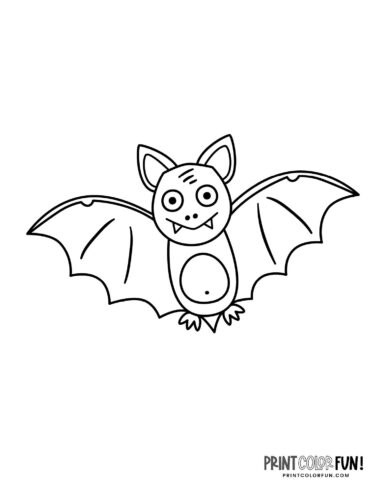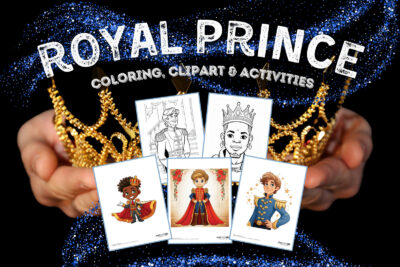Bat coloring pages like the ones below are a gateway to a lot more than just scribble sessions, because they also offer a fun way to explore the fascinating world of bats and their historical connection to Halloween.
Along with the bat cut-out templates and bat stencils you’ll find below, the coloring pages offer the opportunity for a themed adventure filled with facts, crafts, and storytelling. (You can also find out what’s the difference between bats and birds!)
Want to know how to turn a simple coloring activity into an enriching experience that stretches beyond the crayon-filled pages? Here are some tips on how to make the most of combining creativity with learning.
Bats & Halloween: What’s the connection?
So exactly why are bats such a major symbol of Halloween? The roots trace back to ancient Celtic Samhain festivals where bonfires attracted insects, which in turn, attracted bats. As time spun its web, bats became intertwined with Halloween through folklore and vampire tales like Bram Stoker’s Dracula.
ALSO SEE: Boo! These 22 ghost coloring pages are your key to spook-tacular fun
Halloween bat coloring pages
Bats don’t have to be scary! Here are some adorable little bats to color.
20 facts about bats
As your young artist starts coloring, share some of these intriguing facts about bats!
- Bats are the only mammals capable of true flight.
- Over 1,400 species of bats exist worldwide.
- Bats’ wings are actually modified hands with elongated fingers.
- Bats can live for more than 30 years.
- A single bat can eat up to 1,200 mosquitoes in an hour.
- Some bat colonies number in the millions.
- Bats have excellent hearing, using echolocation to navigate and find food.
- Baby bats are called pups.
- Bats help pollinate plants and spread seeds.
- Some species of bats migrate, while others hibernate in winter.
- The smallest bat is the bumblebee bat, weighing in at barely 2 grams.
- Vampire bats do exist, but they typically feed on the blood of cattle.
- Bats’ fast metabolism allows them to digest food within minutes.
- Bats can fly at speeds of up to 100 miles per hour.
- Bats often roost in caves, trees, and under bridges.
- Bats can spread certain diseases, like rabies, but instances are very rare.
- Female bats usually give birth to one pup per year.
- Bats can find their food in total darkness.
- Bats can consume their body weight in insects every night.
- Bats play a crucial role in many ecosystems, controlling insect populations and aiding plant pollination.
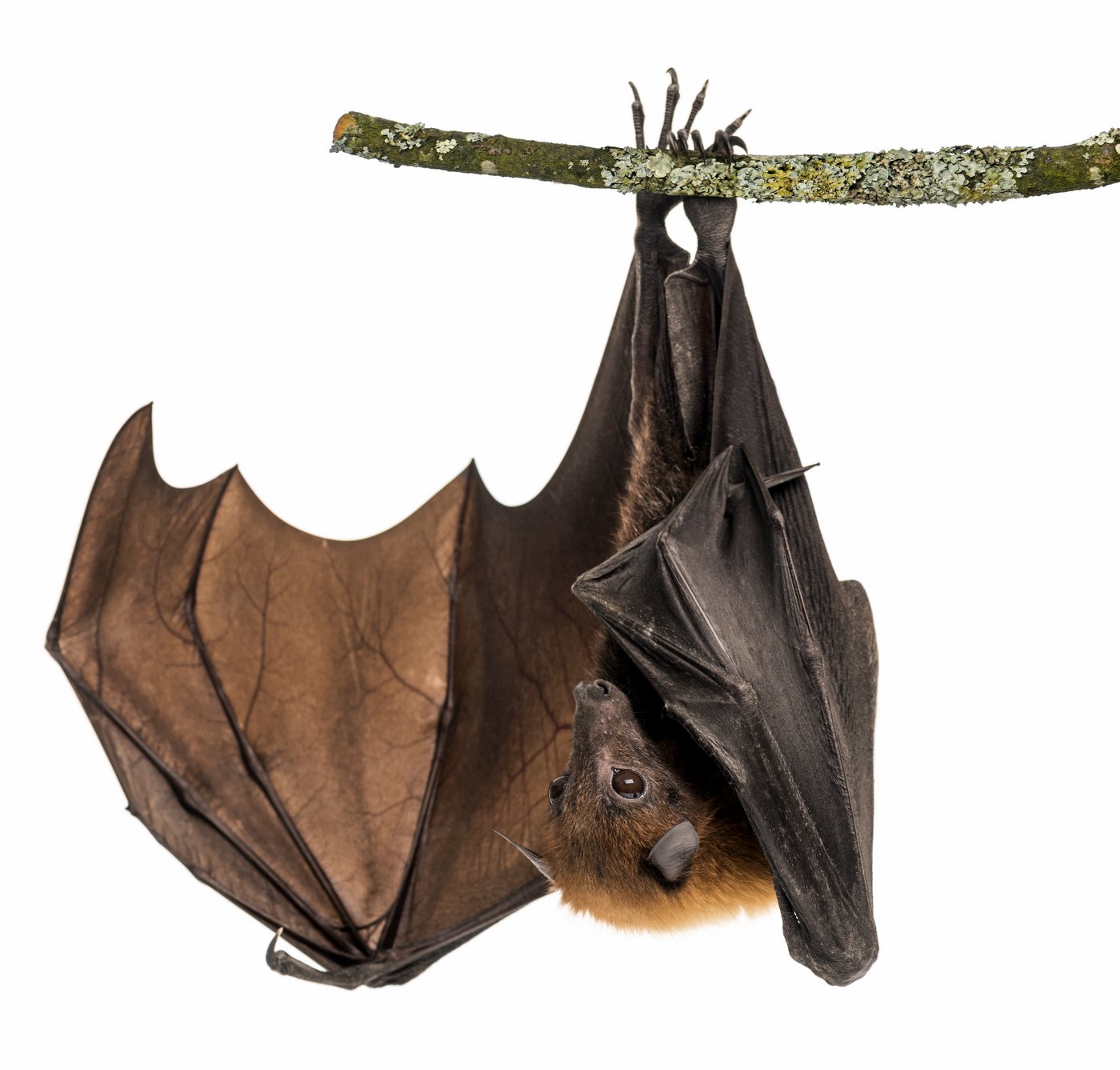
Realistic bat coloring pages
Halloween crafts using bat coloring pages, bat cutout templates & more
This simple coloring activity can be the springboard to a variety of learning adventures:
Crafty creations & other fun ideas:
- Bat mobiles: Use the colored printable bat pages along with the Halloween bat templates below to craft a bat mobile Halloween decoration for your home.
- Stencil silhouettes: Bat stencils can be used to create silhouettes on the walls, further extending the theme of the coloring pages.
- Bat folklore and tales: Explore stories about bats and Halloween, perhaps even creating a storybook using the colored pages as illustrations.
- Food fun: Create edible bat snacks using seedless grapes as bodies, and apple slices as wings to teach about fruit bats and their diet.
Bat cut-out templates for Halloween
3 Halloween bat templates
Print out this template to make this design of three flying bats — color them in, or use the outlines for a cooking or craft project.
6 Halloween bat shape templates/stencils
4 bat stencils – Silhouettes
See the flying bat silhouette in nature
Here are some island flying fox bats or variable flying fox bats (Pteropus hypomelanus) flying into the sunset. This picture was taken as the bats left Kalong Island — known as Fruit Bat Island — for the Indonesian mainland as they do every night.

What’s the difference between bats and birds?
Bats are mammals, birds are not
One of the biggest differences between bats and birds is that bats are mammals, just like humans and dogs, while birds belong to their own group called “Aves.” This means bats and birds can fly, their bodies actually aren’t very much alike.
What makes a mammal?
- Warm-blooded: Both bats and birds are warm-blooded, but being warm-blooded alone doesn’t make you a mammal.
- Fur or hair: Bats have fur on their bodies, which is something mammals have.
- Milk: Baby bats drink milk from their moms, which is something all mammals can do.
What makes a bird?
- Feathers: Birds have feathers, which bats don’t have.
- Beaks: Birds have beaks, but bats have more regular mouths with teeth.
- Lay eggs: Birds lay hard-shelled eggs. Bats give birth to live babies, just like humans.
Different kinds of wings
Bat wings
- Skinny wings: Bats have wings that are more like thin skin stretched between their arm and finger bones.
- Flexible: This makes their wings very flexible, and they can move them like hands to change direction quickly.
Bird wings
- Feathered wings: Birds have wings made of feathers, which are not as flexible as bat wings.
- Strong flyers: Some birds are really good at flying long distances, like migratory birds that travel thousands of miles.
Different ways of living
Bat habits
- Nighttime flyers: Most bats like to fly around at night. They use something called echolocation, which is like making sounds that bounce back to tell them where things are.
- Fruit and Insects: Bats like to eat fruit and insects, and some even eat fish.
Bird habits
- Daytime flyers: Many birds are active during the day and have good eyesight to help them find food and avoid danger.
- Varied diet: Birds eat a variety of foods, including seeds, fruits, and insects. Some birds even eat fish or small animals.
Different places to sleep
Where bats sleep
- Upside down: Bats often like to sleep hanging upside down in dark places like caves or the underside of bridges.
Where birds sleep
- Nests or trees: Birds usually sleep in nests or perch on tree branches. They don’t hang upside down like bats.
So, even though bats and birds both have wings and can fly, they are actually very different from each other in many ways!
Bat coloring page: 3 happy little bats
Silly Halloween bat flying at night coloring page
Cute stylized bat printable to color
Flying vampire bat coloring printable
ALSO SEE: 10 haunted house coloring pages + easy craft activities for Halloween fun
Play the Bat and Moth game
The Bat and Moth game is a playful way to help kids understand the predator-prey dynamic, and the unique echolocation ability of bats. It’s simple, interactive, and can be enjoyed indoors or outdoors — and it’s a wonderful way to get some of that energy out after something like a bat coloring page fine-motor activity. Here’s how to play the game:
Setting up:
- Roles: Designate one player as the bat and another as the moth. If there are more players, you can have more moths or even additional bats.
- Blindfolds: The player representing the bat is blindfolded to mimic the darkness in which bats usually hunt.
- Boundaries: Set clear boundaries for the playing area to ensure safety.
How to play:
- Starting positions: Both the bat and the moth start at opposite ends of the playing area.
- Sound signals:
- The bat emits a clicking sound by either clapping hands or making clicking noises with the mouth. This represents echolocation.
- The moth responds by making a gentle rustling sound, which could be done by tapping feet lightly on the ground or rustling a piece of fabric.
- The chase:
- Guided by the sound signals, the bat tries to catch the moth while the moth tries to evade the bat.
- Encourage the bat to use the echolocation (sound signals) to understand the direction and distance of the moth.
- Switch roles:
- Once the bat catches the moth, or after a set time limit, switch roles and start again.
The Bat and Moth game, coupled with the bat coloring pages, can be a fun way to take a deeper dive into learning about the life and abilities of bats. It’s a hands-on way to learn, bringing some of the wild, nocturnal world of bats into a playful, imaginative setting.

